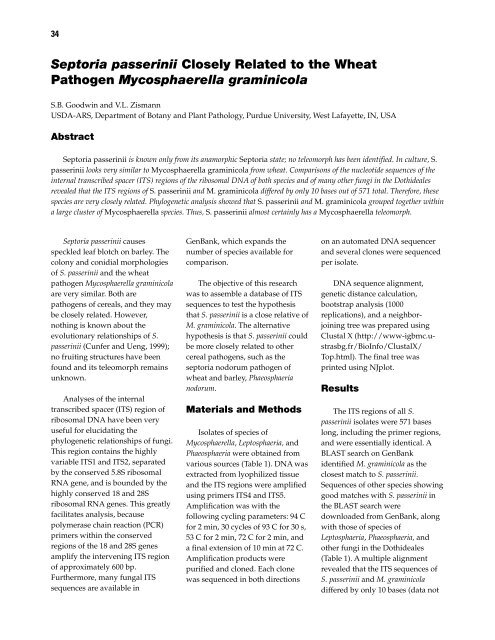Septoria and Stagonospora Diseases of Cereals - CIMMYT ...
Septoria and Stagonospora Diseases of Cereals - CIMMYT ...
Septoria and Stagonospora Diseases of Cereals - CIMMYT ...
You also want an ePaper? Increase the reach of your titles
YUMPU automatically turns print PDFs into web optimized ePapers that Google loves.
34<br />
<strong>Septoria</strong> passerinii Closely Related to the Wheat<br />
Pathogen Mycosphaerella graminicola<br />
S.B. Goodwin <strong>and</strong> V.L. Zismann<br />
USDA-ARS, Department <strong>of</strong> Botany <strong>and</strong> Plant Pathology, Purdue University, West Lafayette, IN, USA<br />
Abstract<br />
<strong>Septoria</strong> passerinii is known only from its anamorphic <strong>Septoria</strong> state; no teleomorph has been identified. In culture, S.<br />
passerinii looks very similar to Mycosphaerella graminicola from wheat. Comparisons <strong>of</strong> the nucleotide sequences <strong>of</strong> the<br />
internal transcribed spacer (ITS) regions <strong>of</strong> the ribosomal DNA <strong>of</strong> both species <strong>and</strong> <strong>of</strong> many other fungi in the Dothideales<br />
revealed that the ITS regions <strong>of</strong> S. passerinii <strong>and</strong> M. graminicola differed by only 10 bases out <strong>of</strong> 571 total. Therefore, these<br />
species are very closely related. Phylogenetic analysis showed that S. passerinii <strong>and</strong> M. graminicola grouped together within<br />
a large cluster <strong>of</strong> Mycosphaerella species. Thus, S. passerinii almost certainly has a Mycosphaerella teleomorph.<br />
<strong>Septoria</strong> passerinii causes<br />
speckled leaf blotch on barley. The<br />
colony <strong>and</strong> conidial morphologies<br />
<strong>of</strong> S. passerinii <strong>and</strong> the wheat<br />
pathogen Mycosphaerella graminicola<br />
are very similar. Both are<br />
pathogens <strong>of</strong> cereals, <strong>and</strong> they may<br />
be closely related. However,<br />
nothing is known about the<br />
evolutionary relationships <strong>of</strong> S.<br />
passerinii (Cunfer <strong>and</strong> Ueng, 1999);<br />
no fruiting structures have been<br />
found <strong>and</strong> its teleomorph remains<br />
unknown.<br />
Analyses <strong>of</strong> the internal<br />
transcribed spacer (ITS) region <strong>of</strong><br />
ribosomal DNA have been very<br />
useful for elucidating the<br />
phylogenetic relationships <strong>of</strong> fungi.<br />
This region contains the highly<br />
variable ITS1 <strong>and</strong> ITS2, separated<br />
by the conserved 5.8S ribosomal<br />
RNA gene, <strong>and</strong> is bounded by the<br />
highly conserved 18 <strong>and</strong> 28S<br />
ribosomal RNA genes. This greatly<br />
facilitates analysis, because<br />
polymerase chain reaction (PCR)<br />
primers within the conserved<br />
regions <strong>of</strong> the 18 <strong>and</strong> 28S genes<br />
amplify the intervening ITS region<br />
<strong>of</strong> approximately 600 bp.<br />
Furthermore, many fungal ITS<br />
sequences are available in<br />
GenBank, which exp<strong>and</strong>s the<br />
number <strong>of</strong> species available for<br />
comparison.<br />
The objective <strong>of</strong> this research<br />
was to assemble a database <strong>of</strong> ITS<br />
sequences to test the hypothesis<br />
that S. passerinii is a close relative <strong>of</strong><br />
M. graminicola. The alternative<br />
hypothesis is that S. passerinii could<br />
be more closely related to other<br />
cereal pathogens, such as the<br />
septoria nodorum pathogen <strong>of</strong><br />
wheat <strong>and</strong> barley, Phaeosphaeria<br />
nodorum.<br />
Materials <strong>and</strong> Methods<br />
Isolates <strong>of</strong> species <strong>of</strong><br />
Mycosphaerella, Leptosphaeria, <strong>and</strong><br />
Phaeosphaeria were obtained from<br />
various sources (Table 1). DNA was<br />
extracted from lyophilized tissue<br />
<strong>and</strong> the ITS regions were amplified<br />
using primers ITS4 <strong>and</strong> ITS5.<br />
Amplification was with the<br />
following cycling parameters: 94 C<br />
for 2 min, 30 cycles <strong>of</strong> 93 C for 30 s,<br />
53 C for 2 min, 72 C for 2 min, <strong>and</strong><br />
a final extension <strong>of</strong> 10 min at 72 C.<br />
Amplification products were<br />
purified <strong>and</strong> cloned. Each clone<br />
was sequenced in both directions<br />
on an automated DNA sequencer<br />
<strong>and</strong> several clones were sequenced<br />
per isolate.<br />
DNA sequence alignment,<br />
genetic distance calculation,<br />
bootstrap analysis (1000<br />
replications), <strong>and</strong> a neighborjoining<br />
tree was prepared using<br />
Clustal X (http://www-igbmc.ustrasbg.fr/BioInfo/ClustalX/<br />
Top.html). The final tree was<br />
printed using NJplot.<br />
Results<br />
The ITS regions <strong>of</strong> all S.<br />
passerinii isolates were 571 bases<br />
long, including the primer regions,<br />
<strong>and</strong> were essentially identical. A<br />
BLAST search on GenBank<br />
identified M. graminicola as the<br />
closest match to S. passerinii.<br />
Sequences <strong>of</strong> other species showing<br />
good matches with S. passerinii in<br />
the BLAST search were<br />
downloaded from GenBank, along<br />
with those <strong>of</strong> species <strong>of</strong><br />
Leptosphaeria, Phaeosphaeria, <strong>and</strong><br />
other fungi in the Dothideales<br />
(Table 1). A multiple alignment<br />
revealed that the ITS sequences <strong>of</strong><br />
S. passerinii <strong>and</strong> M. graminicola<br />
differed by only 10 bases (data not









